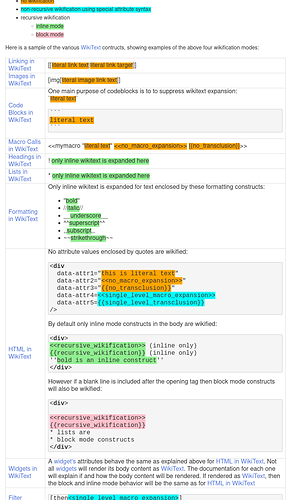Forgive me but I don’t have time at this point, I have a complex issue for a client to resolve, and unfortunately for me what you ask may be difficult for me.
Let me explain, The problem for me is I am not sure I follow the way you communicate the information. I have other ways I understand the same things you address. As I said before “your way” may be quite relevant to others perspective but not to mine, or how I understand tiddlywiki.
It would help if you defined your terms, and then checked that they matched those on tiddlywiki.com
An example is
! only inline wikitext is expanded here
I am not sure what this means because what is excluded here since the following also works ?
! {{transcluded}}
! <<varname>>
! <<macro parm>>
etc...
Then you have
<<mymacro "literal text" <<no_macro_expansion>> {{no_transclusion}}>>
But this works from a recent version;
\define amacro() result
\define mymacro(p1 p2 p3)
$p1$ $p2$ $p3$
\end
<<mymacro "literal text" "<<amacro>>" {{transcludeme}}>>
or with
[then<single_level_macro_expansion>]
We can now use parameter’s
[then<single_level_macro_expansion p1 p2 "p 3">]
The only way I can see being able to help you myself is if you go back to the key information you want to present so I/we can check its valid then see where it may already be documented and summarise it (as you seem to be doing).
Or perhaps your text has too much assumed knowledge and could be more verbose to “spell out” the meaning, with less reliance on color highlights and “titles” like “single_level…”, “inline only” etc…

